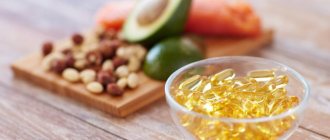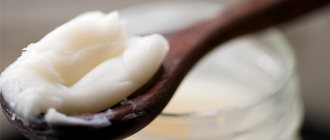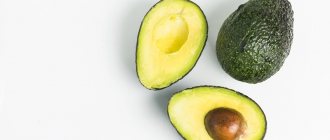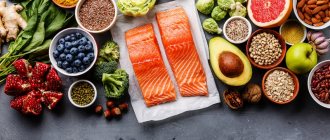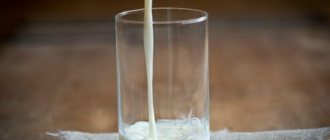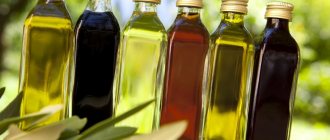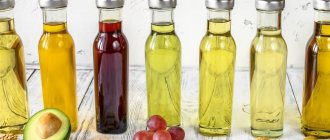Unsaturated fatty acids are monobasic compounds that have one (monounsaturated), two or more (polyunsaturated) double bonds between carbon atoms.
Their molecules are not completely saturated with hydrogen. They are found in all fats. The largest amount of beneficial triglycerides is concentrated in nuts and vegetable oils (olive, sunflower, flaxseed, corn, cottonseed).
Unsaturated fats are used in the fight against excess weight, but it is important to consume them correctly. They speed up metabolism, suppress appetite, and suppress the production of cortisol (stress hormone), which causes overeating. In addition, beneficial acids reduce leptin levels and block the gene responsible for the accumulation of fat cells.
What are the benefits of fats for the human body?
Not only excess, but also lack of fat can cause serious health problems. You must consume fat every day to keep your body functions in order. The benefits of fats for the body are as follows:
- They supply the body with essential fatty acids omega-3 and omega-6, which it cannot produce on its own. These fatty acids play an important role in maintaining healthy heart and brain cells. In addition, they fight inflammation, influence cell signaling and many other cellular functions, as well as human mood and behavior.
- Fat helps absorb certain nutrients, such as fat-soluble vitamins (A, D, E, and K) and antioxidants (such as lycopene and beta-carotene). Meanwhile, vitamin A is necessary for good vision, vitamin D for calcium absorption, healthy bones and teeth, E for protecting cells from free radicals and beautiful skin, and K for normal blood clotting.
- Fats are a source of energy and the main way of storing it. 1 gram of fat contains 9 calories, while carbohydrates and protein contain only 4, and alcohol contains 7. And although carbohydrates are the main source of energy for the body, our body uses fat as a “reserve fuel” when there are not enough carbohydrates.
- Adipose tissue insulates the body and helps maintain its normal temperature. Other fat cells surround vital organs and protect them from external influences. At the same time, adipose tissue is not always visible and is noticeable only when you are overweight.
- Finally, fat plays an important role in the maintenance of all cells in the body. Cell membranes themselves are made from phospholipids, which means they are also fatty. Many tissues in the human body are lipid (i.e., fatty), including our brain and the fatty membrane that insulates the nervous system.
Simply put, all the fat we consume:
- or becomes part of the tissues and organs in our bodies,
- or used as energy,
- or stored in adipose tissue.
Therefore, even if you are losing weight, dietary sources of fat should definitely be part of your diet.
By the way, how “dangerous” are fats for weight loss?
People gain weight when they consume more calories (from fat, carbohydrates, protein and alcohol) than they burn. Therefore, it is usually not so much fatty foods that are to blame for excess weight, but overeating in general + low physical activity, as well as sugar. This is what actually causes the accumulation of fat in the body. High blood sugar causes the pancreas to release insulin, which causes fat cells to take up excess glucose and turn it into more fat on your sides.
Yes, as we said above, fat contains more calories per gram than protein, carbs, and even alcohol, but it also makes food more flavorful and filling. And this allows you to quickly feel satisfied with food without overeating. A weight loss diet that includes some fats will not only be healthier, but will also be more successful in the long run because you will be less likely to relapse.
Another thing is that fat often comes to us from such tempting sources as French fries, hamburgers, cakes, thick steaks, etc. Perhaps that is why, according to statistics, the average people's diet contains not 20-35 recommended% fat, but 35 -40%. As a result, all the benefits of fats for the body begin to turn into harm. Exceeding the consumption of fatty foods often leads to the following problems:
- Excess weight.
- High cholesterol levels, which in turn increases the risk of developing coronary heart disease.
- The likelihood of developing type 2 diabetes.
- Increased risk of heart disease and certain types of cancer (particularly breast and colon cancer).
To avoid this, it is recommended that women eat no more than 70 grams of fat per day, and men no more than 95 grams. To get a more individual figure, base your calorie goal on your diet. So, with a goal of consuming 1800 Kcal per day, the amount of fat consumed should be 360-630 Kcal or 40-70 g. Some nutritionists also recommend following a simple rule: eat 1 g of fat per 1 kg of body weight per day.
So, what fats are best to choose for weight loss and overall health?
Useful features
There is nothing superfluous in physiology; every substance is irreplaceable. So fats perform many important tasks:
- Structural element of cell membranes
This is the same cholesterol that they scare us with. It turns out that without it, cells stop dividing and functioning normally.
- Production of sex hormones
Excluding fatty foods from the diet leads to sexual dysfunction.
- Absorption of vitamins A, E, D
These are fat-soluble substances that cannot penetrate the intestinal mucosa without lipid molecules. Diet leads to their deficiency - nails, hair, and skin elasticity suffer. Sleep is disturbed, the person becomes nervous and irritable.
- Energy for the brain
The brain receives most of the energy for its work from the breakdown of fats. Neuronal membranes are 30% composed of omega-3, 6 fatty acids. Their deficiency leads to disruption of all cortical functions: memory, attention, volitional qualities.
- Protection and thermal insulation
Internal fat surrounding the organs absorbs shock, performing a protective function. Subcutaneous tissue is a “fur coat” that protects us from hypothermia or overheating.
Incorrect diets with thoughtless restriction of fatty foods lead a person to a bunch of chronic diseases. To prevent this from happening, you need to be able to distinguish healthy fats from harmful ones.
Which fats are most beneficial for the body?
Choosing the right sources of fat for your diet is one of the best ways to reduce your risk of heart disease. For this purpose (and maintaining overall health), the most beneficial are unsaturated fatty acids. Here is their list:
- polyunsaturated fats omega-3 and omega-6;
- monounsaturated fats omega-7 and omega-9.
Polyunsaturated fats
supply the body with essential fatty acids, help reduce bad cholesterol and triglyceride levels, support healthy bones, hair, skin, immunity and reproductive function.
Omega 3
fatty acids help strengthen the heart, protect blood vessels in the brain, support the immune system and improve mood. Among the healthy omega-3 fats, the most important for humans are ALA (alpha-linolenic acid), DHA (docosahexaenoic acid) and EPA (eicosapentaenoic acid). Alpha-linolenic acid has a beneficial effect on the heart and enters the body from plant sources (flax seeds, hemp seeds, chia, etc.). The other two acids can be obtained primarily from fatty fish (salmon, trout, herring, mackerel) and other seafood. It is believed that fish contains the most effective type of omega-3 for the prevention of cardiovascular diseases. The American Heart Association recommends eating 2 servings of oily fish per week.
Read on Forest Fairy: The best vitamins for beautiful skin
Omega 6 fatty acids
play an important role in brain function, normal growth and development, skin and eye health. Omega-6 linoleic acid is used by our bodies to create cell membranes. However, evolutionary scientists believe that modern humans consume too much omega-6 and not enough omega-3. In a hunter-gatherer diet, the ratio of these fats would be approximately 1:1, whereas the current average is 16:1. Excessive amounts of omega-6 in the diet can lead to inflammation, which is associated with heart disease. In addition, these fatty acids often come to us from refined foods rather than from whole foods. Omega 6 can be found in meat, eggs, corn, sunflower, soybean and safflower oils.
Other healthy fats, monounsaturated fatty acids
, also reduce the risk of heart disease, help lower bad LDL cholesterol, increase good HDL cholesterol, protect arteries from plaque buildup, and are often a good source of the antioxidant vitamin E. They are found in high quantities in nuts, avocados, and olives.
The discovery that monounsaturated fats are beneficial for the body came from the Seven Countries Study in the 1960s. It showed that people in Greece and other parts of the Mediterranean region have relatively low rates of heart disease despite eating a high-fat diet. It is noteworthy that the main fat in their diet was not saturated animal fat, but olive oil, which is a rich source of monounsaturated fat. This discovery sparked a surge of interest in olive oil and the Mediterranean diet in general as a healthy eating style.
Although there is currently no recommended daily intake of monounsaturated fats, nutritionists recommend consuming them along with polyunsaturated fats to replace saturated and trans fats in your diet.
What can we conclude from all this?
If we want to stay healthy, active and get sick less, we need to pay attention to what fats are present in our diet and in what proportion. To ensure that the diet does not skew towards the “wrong” fats, we adhere to the following rules:
- We limit the consumption of saturated fats (fatty meat, chicken with skin, processed foods and sausages). Convenience foods, sausages, as well as various store-bought sweets should also be limited because they contain so-called trans fats, or freak fats . They are formed in large quantities as by-products during the hydrogenation of unsaturated fats, for example in the production of margarine (a cocoa butter substitute) from sunflower oil. Consumption of trans fats has been shown to increase cardiovascular disease and mortality. In this regard, WHO and other health organizations recommend avoiding the consumption of trans fats. If you are unable to give up these products right away, then let them be rare guests on your table at first - on holidays. We replace them with lean meat (turkey, skinless chicken, rabbit) and fish, best prepared independently, and homemade sweets.
- Don't forget about fat consumption standards! For a healthy person, 50-70 g of fat (but not less than 30 g) is enough - this is roughly 1 tablespoon of vegetable oil and 1 tablespoon of animal fat (obtained from meat and dairy products with a balanced diet) per day.
- High-quality fats are, first of all, mono- and polyunsaturated fats. Therefore, we include in our diet fatty fish (2-3 times a week) and unrefined vegetable oil (olive, flaxseed, sesame, walnut, avocado), but we measure the amount of vegetable oil with spoons, and do not pour it from the heart.
- Supplements to the diet in the form of Omega-3 will not be superfluous: as a prevention of atherosclerosis and ischemic heart disease, and necessarily in case of existing problems with the cardiovascular system. The norm is 1 g per day (1000 mg of two acids - eicosapentaenoic and docosahexaenoic).
Cheers!
Did you like the article? I would be grateful if you share it on social media. networks with your friends.
PS: If you need individual advice, more details can be found here.
Saturated and unsaturated fats: difference, ratio in the diet
As you probably know, the fat we eat comes in two main forms: unsaturated and saturated. Both types provide approximately the same amount of calories. Therefore, to lose weight, it doesn’t matter what fats you eat. Too many calories? This means that you will gain weight, regardless of whether healthy fatty acids enter your body or not.
What's the difference between saturated and unsaturated fats, and why are some better than others?
The term “saturated” refers to the number of hydrogen atoms that surround each carbon atom in fat. The more hydrogen, the more saturated the fat. In reality, this is expressed as follows: saturated fats become solid
(remember how, after frying meat, bacon or lard, melted animal fat in a frying pan gradually solidifies), while unsaturated fat remains
fluid
(like most vegetable oils).
The ability of saturated fats to harden is widely used in the production of confectionery and bakery products. Composed of butter, palm oil and milk fat, they are found in all kinds of desserts, cakes, pastries and various pastries. Other sources of saturated fat include meats, cheeses and other whole milk products, and coconut oil.
Is saturated fat harmful to human health?
In fact, research has not yet collected enough evidence that saturated fat increases the risk of heart disease. There is incomplete evidence that excessive consumption of these hardening fats contributes to increased total cholesterol, plaque buildup in the arteries, and an increased risk of colon and prostate cancer. 2 large studies have shown that replacing saturated fat with polyunsaturated fats and high-fiber carbohydrates actually reduces the risk of heart disease (while a diet high in processed carbohydrates does the opposite).
However, humans have evolved to consume unprocessed forms of saturated fat (game meat, whole milk, eggs, coconuts) along with fish and plant foods. Therefore, some of them should also be present in our diet, at least for:
- reducing levels of lipoprotein (a), high levels of which increase the risk of heart disease;
- cleansing the liver of fat (saturated fat stimulates liver cells to release it);
- brain health (most of the brain and myelin sheath is made of saturated fat);
- proper functioning of the immune system (saturated fats such as myristic and lauric acids play an important role in maintaining immunity and are even found in mothers' breast milk).
The correct ratio of unsaturated and saturated fats in the diet
Due to the availability of animal products and the low prevalence of whole plant foods on the market today, people have become consuming too much saturated fat in relation to unsaturated fat. And what's even worse is to combine them with processed carbohydrates, which usually leads to health problems.
If total fat in a person's diet should be 20-35% of all calories, then saturated fat should not be more than 10% (about 20 grams with a goal of 1800 Kcal/day). This is the ratio recommended by the WHO and most other health experts, while the American Heart Association advises sticking to a threshold of 7% of total calories, or no more than 14 grams.
Recommendations from nutritionists
To prevent fats in food from causing harm instead of benefit, nutritionists advise adhering to the following rules when creating a diet:
- Ignore foods containing trans fats.
- Prepare food without using margarine or other hydrogenated oils.
- Prepare dessert pastries yourself, rather than buying them from pastry stores.
- Don't indulge in low-fat foods.
- Before cooking, trim off the skin and fat from the meat.
- Eat fish and seafood weekly.
- Include dairy and fermented milk products in your menu every day.
It is advisable, if possible, not to heat-treat vegetable oils when preparing dishes. Some oils (for example, flaxseed) even release toxic substances when exposed to temperature. According to nutritionists, it is best to fry food in olive oil.
IMPORTANT! Informational article! Before use, you should consult a specialist.
Which fats are really dangerous?
There is still one type of fat that a person should completely exclude from his diet. These are trans fatty acids
, which are found in nature only in small doses and enter the body, usually from processed foods.
Most trans fats are found in margarine and other hydrogenated oils. To produce it, vegetable oil is heated in the presence of hydrogen and a heavy metal catalyst (such as palladium). This causes hydrogen to bond with the hydrocarbon present in the oil and convert the fat from liquid and perishable to a solid and shelf-stable
product.
Unlike saturated and unsaturated fats, trans fats are empty calories that provide no benefit to the human body. On the contrary, a diet high in trans fats contributes to:
- increased bad LDL cholesterol and the development of cardiovascular diseases;
- increased risk of developing colon and breast cancer;
- complications of pregnancy (early labor and preeclampsia) and disorders in infants, since trans fats are transmitted from mother to fetus;
- development of allergies, asthma and asthmatic eczema in adolescents;
- development of type II diabetes;
- obesity (source).
In a 6-year study, monkeys on a trans fat diet gained 7.2% of their body weight, while monkeys on a monounsaturated fat diet gained just 1.8%.
Trans fats are worse than any other fat, including butter or lard. There is no safe level of consumption: even 2% of total calories (4 grams for a goal of 1800 kcal) increases the risk of heart disease by 23%!
The highest amounts of trans fatty acids are found in cakes, cookies and bread (about 40% of total consumption), animal products (21%), French fries (8%), margarine (7%), chips, popcorn, candy and breakfast cereals (5% each), as well as confectionery fat (4%). You'll find it in all foods containing partially hydrogenated oil, most fast foods, frostings, dairy-free creamers, and ice cream. Try to avoid such foods!
Summarize
- Monounsaturated fats are an important part of a healthy diet for all people.
- Diets high in healthy fats are associated with normal body weight, while low-fat diets are dangerous and unhelpful.
- All three types of healthy fats (saturated, monounsaturated, and polyunsaturated) should be consumed regularly, although research suggests that saturated fat should be consumed less than the other two types of fat. As for trans fats, their consumption should be completely avoided.
- Monounsaturated fats are an effective natural defense against cardiovascular disease, insulin resistance, many types of cancer, weak bones and depression.
You need to get enough monounsaturated fats from organic foods. Olive oil, eggs and red meat in some cases may contain low amounts of MUFA due to the presence of GMOs, feeding livestock unhealthy feeds and unnatural lifestyle of animals.
Healthy fats: food list
Below we have compiled for you a list of foods that contain the most healthy polyunsaturated and monounsaturated fats. All figures are taken from the database for standard reference and are based on 100g of each product. Keep it in mind and use it for your health!
As you can see, natural vegetable oils are the richest and healthiest sources of unsaturated fats. For comparison, we provide you with data on other popular fats, including poultry and fish.
What are monounsaturated fats?
In biochemistry and nutrition, monounsaturated fatty acids
Abbreviated MUFAs or
monounsaturated fats,
are fatty acids that have one double bond in the fatty acid chain with all the remaining carbon atoms.
In contrast, polyunsaturated fatty acids (PUFAs) have more than one double bond.
Monounsaturated fats have two forms - cis and trans. In cis configurations, the hydrogen atoms are on one side of the double bond, and in trans configurations, they are on the opposite side. []
Trans-monounsaturated fatty acids are semi-solid fats produced by industrial processes that partially convert butter into saturated fats (partially hydrogenated fats) such as margarine. These are typically unhealthy monounsaturated fats , which are believed to cause inflammation, heart disease, and atherosclerosis. [The] exception is trans-palmitoleic acid, which is associated with lower levels of total cholesterol , triglycerides , and C-reactive protein .
The predominant natural form of monounsaturated fatty acids is the cis form.
PLANT SOURCES OF MONOUNSATURATED FATS
Monounsaturated fats in foods:
- Nuts
- Avocado
- Olives
- Animal fats, including lard
What other foods contain unsaturated fats?
Seeds and nuts are ideal foods high in unsaturated fatty acids. You can't eat a lot of butter, can you? And they can be safely used as a snack, which will additionally serve your body as a source of vitamins and other important microelements. Read more in the article The healthiest nuts and their properties.
Harm
Excessive consumption of triglycerides leads to negative consequences in the form of:
- development of arthritis, multiple sclerosis;
- premature aging;
- hormonal imbalance in women;
- accumulation of slags;
- increased load on the liver and pancreas;
- formation of gallstones;
- intestinal inflammation, constipation;
- gout;
- coronary vascular diseases;
- breast cancer, prostate cancer;
- irritation of the gastrointestinal tract, the appearance of gastritis.
Under the influence of heat treatment, healthy fats polymerize and oxidize, breaking down into dimers, monomers, and polymers. As a result, the vitamins and phosphatides in them are destroyed, which reduces the nutritional value of the product (oil).
Other sources of unsaturated fats
Finally, here is another list of weight loss foods that contain healthy fats. They are not as rich in unsaturated fatty acids per 100g as oils and nuts, but can also be part of your daily diet.
Thank you for reading this article to the end! Now you know which fats are healthy and how much you need to eat to stay healthy. In conclusion, we want to share with you two secrets on how to eat less tempting fatty foods and processed carbohydrates:
- Eat less, but more often - every 3 hours, for example, making a snack of non-roasted nuts.
- Add more protein and fiber-rich foods to your diet to help you avoid overeating and feel fuller longer.
Be healthy!
Oleic acid
Oleic acid , or omega-9 , is an essential fatty acid, which means that the body cannot synthesize it and must be present in the diet . It can help control your immune system and benefit your health. []
For example, olive oil is 70-80% oleic acid. Many studies have described its health benefits, such as lowering cholesterol, lowering blood pressure, reducing inflammation, and protecting against breast cancer. []
Oleic acid helps lower cholesterol levels
Oleic acid blocks the absorption of cholesterol in the small intestine . It reduces the expression of the cholesterol transport protein NPC1L1 by suppressing the unfolded protein response (UPR) pathway in CaCo-2 enterocytes. []
Oleic acid reduces the risk of breast cancer
Oleic acid stops the growth of cancer cells by []:
- suppression of over-expression of the HER2 gene (a known oncogene)
- using more calcium for intercellular communication
- inducing apoptosis of cancer cells.
MECHANISM OF ACTION OF OLEIC ACID AT THE MOLECULAR LEVEL (source)
Oleic acid is involved in reducing inflammation
Oleic acid may reduce inflammation due to saturated fat in human cells. It reduces the production of ICAM-1 (cell adhesion molecule), which is part of the inflammatory response, and inhibits phospholipase A2, which is an inflammatory enzyme. []
Oleic acid helps lower blood pressure
Oleic acid reduces the stability of the cell membrane, which increases the activity of the adrenaline receptor (α2-adrenergic receptor), leading to a decrease in blood pressure . []
Content of polyunsaturated fatty acids in products of plant origin
Table of the percentage content of polyunsaturated fatty acids in products from the category - products of plant origin.
| Product | Content |
| Grape seed oil | 69.90 g |
| Flaxseed oil | 67.85 g |
| Walnut oil | 63.30 g |
| Poppy oil | 62.40 g |
| Wheat germ oil | 61.70 g |
| Soybean oil | 57.74 g |
| Corn oil | 54.68 g |
| Cottonseed oil | 51.90 g |
| Walnut | 47.17 g |
| Butternut | 42.74 g |
| Sesame oil | 41.70 g |
| Oat oil | 40.87 g |
| Hemp seed | 38.10 g |
| Black Walnut | 36.44 g |
| Rice bran oil | 35.00 g |
| Pine nut without shell | 34.07 g |
| Roasted sunflower seeds (hulled) | 32.88 g |
| Peanut butter | 32.00 g |
| Apricot oil | 29.30 g |
| Flaxseed | 28.73 g |
| Poppy seeds | 28.57 g |
| Canola oil | 28.14 g |
| Unroasted sesame | 25.49 g |
| Brazilian nut | 24.40 g |
| Chia seeds | 23.67 g |
| Sunflower seeds, peeled | 23.14 g |
| Pecan | 21.61 g |
| Mustard oil | 21.23 g |
| Roasted sesame | 21.04 g |
| Peeled pumpkin seeds | 20.98 g |
| Beechnut | 20.09 g |
| Almond oil | 17.40 g |
| Sesame flour | 16.26 g |
| Peanuts raw | 15.56 g |
| Fresh pistachios | 14.38 g |
| Avocado oil | 13.49 g |
| Roasted pistachios (no salt) | 13.35 g |
| Roasted almonds | 12.96 g |
| Fresh almonds | 12.33 g |
| Onion rings | 12.15 g |
| Olive oil | 10.52 g |
| Hazelnut oil | 10.20 g |
| Mustard seeds ground mustard | 10.09 g |
| Roasted peanuts | 9.77 g |
| Palm oil | 9.30 g |
| Halva | 8.48 g |
| Roasted hazelnuts | 8.46 g |
| Ground dry chili pepper | 8.01 g |
| Fresh hazelnuts | 7.92 g |
| Cashew raw | 7.85 g |
| Roasted cashews | 7.84 g |
| Walnut drank | 7.61 g |
| Unheated rice bran | 7.46 g |
| Shea butter (karite) | 5.20 g |
| Boiled soybeans (ripe) | 5.06 g |
| Chocolate cupcake with chocolate icing | 4.62 g |
| Fermented tofu cheese (fuyu) | 4.52 g |
| Marjoram spice powder | 4.41 g |
| Nutmeg spice, ground | 4.39 g |
| Tempe | 4.30 g |
| Sunflower oil | 3.80 g |
| Fresh sprouted soybeans | 3.78 g |
| Celery seeds | 3.72 g |
| Dried tarragon | 3.70 g |
| Cloves (spice) seasoning powder | 3.61 g |
| Caramel | 3.48 g |
| Oat flour | 3.33 g |
| Jeera cumin seeds | 3.28 g |
| Cumin seeds | 3.27 g |
| Anise seeds | 3.15 g |
| Hot chili peppers dried in the sun | 3.08 g |
| Cacao butter | 3.00 g |
| Unheated oat bran | 2.77 g |
| Dry chickpeas | 2.73 g |
| Soy protein powder | 2.70 g |
| Dry soy tofu cheese | 2.66 g |
| Millet flour | 2.62 g |
| Ground allspice | 2.36 g |
| Bay leaf | 2.29 g |
| Unheated wheat bran | 2.21 g |
| Dry corn kernels | 2.16 g |
| Edamame cooked | 2.16 g |
| Saffron spice | 2.07 g |
| Reveler seeds | 2.02 g |
| Avocado fresh | 1.82 g |
| Dried openwork chervil | 1.80 g |
| Ground sage | 1.76 g |
| Rice bran bread | 1.76 g |
| Yellow whole grain corn flour | 1.76 g |
| Coriander seeds | 1.75 g |
| White corn flour (masa) | 1.72 g |
| Coconut oil | 1.70 g |
| Fennel seeds | 1.69 g |
| Hard tofu cheese (linen) | 1.65 g |
| Soy Protein (Isolate) Powder | 1.65 g |
| White wheat bread | 1.62 g |
| Babassu oil | 1.60 g |
| Whole grain wheat bread | 1.59 g |
| French fries | 1.50 g |
| Macadamia nut | 1.50 g |
| Roasted macadamia nut | 1.50 g |
| Whole grain sorghum flour | 1.40 g |
| Oregano oregano, dried | 1.37 g |
| Canned green olives | 1.31 g |
| Whole grain flour (wheat) | 1.17 g |
| Boiled chickpeas | 1.16 g |
| Quinoa boiled in water | 1.08 g |
| Fresh grape leaves | 1.07 g |
| Soybean cake | 1.05 g |
| Dry green buckwheat | 1.04 g |
| Dill seeds | 1.01 g |
| Ground black pepper | 1.00 g |
| Brown rice flour | 1.00 g |
| Malted barley flour | 0.95 g |
| Buckwheat flour | 0.95 g |
| Ginger extract powder | 0.93 g |
| Fresh rosemary | 0.90 g |
| Sunflower flour | 0.87 g |
| Pancakes | 0.82 g |
| Gluten (wheat gluten) in dry form | 0.81 g |
| Rye bread | 0.80 g |
| Triticale flour | 0.79 g |
| Table mustard, paste | 0.77 g |
| Barley flour | 0.77 g |
| Turmeric spice powder | 0.76 g |
| Lupine (lupine beans) cooked | 0.73 g |
| Unsweetened coconut flakes | 0.71 g |
| Corn flour | 0.70 g |
| Wheat bran bread | 0.65 g |
| Boiled corn | 0.60 g |
| Canned olives | 0.59 g |
| Rye flour | 0.58 g |
| Fresh sprouted wheat | 0.56 g |
| Rye bread | 0.56 g |
| Fresh thyme | 0.53 g |
| Fresh sprouted variegated beans (Pinto) | 0.52 g |
| Canned corn | 0.52 g |
| Fresh peppermint | 0.51 g |
| Millet boiled in water | 0.51 g |
| Chestnut, peeled, fresh | 0.49 g |
| Boiled white beans | 0.49 g |
| Raw corn | 0.49 g |
| Sorghum flour | 0.48 g |
| Morel mushrooms, raw | 0.43 g |
| Cardamom | 0.43 g |
| Fresh vegetable physalis | 0.42 g |
| All-purpose wheat flour | 0.41 g |
| Fresh passion fruit | 0.41 g |
| Fresh sprouted alfalfa seeds | 0.41 g |
| Fresh guava | 0.40 g |
| Fresh mint | 0.39 g |
| Fresh basil | 0.39 g |
| Rice flour | 0.38 g |
| Fresh raspberries | 0.38 g |
| Boiled long grain brown rice | 0.37 g |
| Fresh coconut meat | 0.37 g |
| Quinoa fresh | 0.35 g |
| Chinese fresh broccoli | 0.35 g |
| Canned blackberry juice | 0.34 g |
| Horseradish, ready to eat | 0.34 g |
| Raw curly cabbage | 0.34 g |
| Dried bananas | 0.34 g |
| Chinese cooked broccoli | 0.33 g |
| Fresh sprouted peas | 0.33 g |
| Fresh arugula | 0.32 g |
| Fresh gooseberries | 0.32 g |
| Lotus seeds | 0.31 g |
| Fresh green beans | 0.31 g |
| Fresh dandelion leaves | 0.31 g |
| Pickled capers | 0.30 g |
| Boiled green beans | 0.30 g |
| Boiled brown rice | 0.30 g |
| Fresh kiwi | 0.29 g |
| Fresh blackberries | 0.28 g |
| Boiled red beans (Kidney) | 0.28 g |
| Red beans (Kidney) sprouted fresh | 0.28 g |
| Steamed brown rice | 0.27 g |
| Fresh chives | 0.27 g |
| Fresh coconut milk | 0.26 g |
| Boiled Brussels sprouts | 0.26 g |
| Raw garlic | 0.25 g |
| Fresh elderberry | 0.25 g |
| Sauerkraut (kimchi) | 0.24 g |
| Red hot fresh chili pepper | 0.24 g |
| Boiled variegated beans (Pinto) | 0.24 g |
| Fried portobello mushrooms | 0.23 g |
| Boiled black beans | 0.23 g |
| Fresh watercress | 0.23 g |
| Boiled black-eyed beans | 0.23 g |
| Fresh sprouted lentils | 0.22 g |
| Yogurt | 0.22 g |
| Raw wakame seaweed | 0.22 g |
| Boiled cauliflower | 0.22 g |
| Barley boiled in water (barley porridge) | 0.21 g |
| Prickly pear (fruit) fresh | 0.21 g |
| Boiled wild rice | 0.21 g |
| Boiled pink beans | 0.21 g |
| Fresh mulberries | 0.21 g |
| Boiled pigeon peas | 0.21 g |
| Canned heart of palm | 0.20 g |
| Fresh kale | 0.20 g |
| Soy protein (concentrate) powder | 0.20 g |
| Mashed potatoes with milk and butter, prepared | 0.20 g |
| Buckwheat boiled in water (buckwheat porridge) | 0.19 g |
| Cherimoya fresh | 0.19 g |
| Fresh green peas | 0.19 g |
| Starfruit (starfruit) fresh | 0.18 g |
| Fresh black currant | 0.18 g |
| Frozen logan berry | 0.18 g |
| Lentils boiled in water | 0.18 g |
| Cooked cabbage (boiled) | 0.17 g |
| Fresh kumquat | 0.17 g |
| Boiled broccoli | 0.17 g |
| Fennel, raw (fruit or root) | 0.17 g |
| Fresh leek | 0.17 g |
| Peas boiled in water (ripe) | 0.17 g |
| Fresh spinach | 0.17 g |
| Boiled beans (ripe) | 0.16 g |
| Canned green peas | 0.16 g |
| Raw champignons | 0.16 g |
| Fried champignons | 0.16 g |
| Fresh Roman salad | 0.16 g |
| Fresh onion | 0.16 g |
| Fresh strawberries | 0.16 g |
| Raw ginger root | 0.15 g |
| Fresh Brussels sprouts | 0.15 g |
| Fried or baked zucchini (without oil) | 0.15 g |
| Potato starch | 0.15 g |
| Broccoli raab cooked | 0.15 g |
| Fresh amaranth leaves | 0.15 g |
| Soy sauce (hydrolyzed) | 0.15 g |
| Fresh blueberries | 0.15 g |
| Boiled artichokes | 0.15 g |
| Boiled green beans (asparagus) | 0.15 g |
| Fresh figs | 0.14 g |
| Feijoa fresh | 0.14 g |
| Seedless raisins | 0.14 g |
| Fresh lychees | 0.13 g |
| Fresh chicory leaves | 0.13 g |
| Fresh broccoli raab | 0.13 g |
| Boiled mung bean | 0.13 g |
| Fresh parsley | 0.12 g |
| Raw oyster mushrooms | 0.12 g |
| Iris | 0.12 g |
| Fresh turnip tops | 0.12 g |
| Carrots raw (fresh) | 0.12 g |
| Fresh head lettuce | 0.12 g |
| Leeks cooked | 0.11 g |
| Nori seaweed, raw | 0.11 g |
| Radicchio fresh | 0.11 g |
| Boiled spinach | 0.11 g |
| Spirulina raw | 0.11 g |
| Boiled asparagus | 0.11 g |
| Rhubarb stem raw | 0.10 g |
| Bulgur boiled in water (porridge) | 0.10 g |
| Boiled bamboo shoots | 0.10 g |
| Fresh black persimmon (sapota) | 0.10 g |
| Fresh Chinese cabbage | 0.10 g |
| Fresh dill | 0.10 g |
| Fresh pear | 0.09 g |
| Fresh jackfruit | 0.09 g |
| Cooked eggplant | 0.09 g |
| Ready-made espresso coffee | 0.09 g |
| Fresh medlar | 0.09 g |
| Steamed boiled rice | 0.09 g |
| Maitake mushrooms raw | 0.09 g |
| Enoki mushrooms raw | 0.09 g |
| Barbados cherry fresh | 0.09 g |
| Fresh cherries | 0.09 g |
| Boiled carrots | 0.09 g |
| Fresh lemon, without peel | 0.09 g |
| Fresh red or white currants | 0.09 g |
| Raw rutabaga | 0.09 g |
| Chicory root, raw | 0.09 g |
| Fresh endive | 0.09 g |
| Fresh peach, pitted | 0.09 g |
| Fresh tomatoes | 0.08 g |
| Fresh lettuce | 0.08 g |
| Fresh cantaloupe melon | 0.08 g |
| Escarole cooked | 0.08 g |
| Fresh red cabbage | 0.08 g |
| Fresh pomegranate | 0.08 g |
| Fresh celery | 0.08 g |
| Fresh Antillean apricot | 0.08 g |
| Fresh apricot | 0.08 g |
| Boiled long grain rice | 0.08 g |
| Fresh iceberg lettuce | 0.07 g |
| Dried apricots | 0.07 g |
| Fresh bananas | 0.07 g |
| Boiled onions | 0.07 g |
| Cooked squash | 0.07 g |
| Fresh red lettuce | 0.07 g |
| Mango fresh | 0.07 g |
| Fresh red bell pepper | 0.07 g |
| Cranberry juice without sugar | 0.07 g |
| Fresh chard | 0.07 g |
| Boiled glutinous (sticky) rice | 0.07 g |
| Fresh soursop | 0.07 g |
| Fresh plantains | 0.07 g |
| Cinnamon powder | 0.07 g |
| Fresh breadfruit | 0.07 g |
| Fresh tangerines | 0.07 g |
| Boiled beets | 0.06 g |
| Couscous boiled in water | 0.06 g |
| Fresh green onion | 0.06 g |
| Green bell pepper, fresh | 0.06 g |
| Yams cooked | 0.06 g |
| Raw beets | 0.06 g |
| Fresh melon | 0.06 g |
| Fresh tamarind | 0.06 g |
| Fresh papaya | 0.06 g |
| Fresh sprouted mung bean | 0.06 g |
| Chayote raw | 0.06 g |
| Boiled rice (in water) | 0.06 g |
| Fresh cranberries | 0.06 g |
| Fresh lime | 0.06 g |
| Boiled burdock root | 0.06 g |
| Turnips raw | 0.05 g |
| Boiled kohlrabi (cabbage) | 0.05 g |
| Fresh apples | 0.05 g |
| Canned pomegranate juice | 0.05 g |
| Boiled round grain rice | 0.05 g |
| Fresh quince | 0.05 g |
| Raw asparagus | 0.05 g |
| Fresh watermelon | 0.05 g |
| Fresh savoy cabbage | 0.05 g |
| Fresh radish | 0.05 g |
| Fresh kohlrabi | 0.05 g |
| Grapes (red or green) fresh | 0.05 g |
| Raw seaweed | 0.05 g |
| Parsnip root raw | 0.05 g |
| Fresh beet tops | 0.05 g |
| Taro cooked tubers | 0.05 g |
| Fresh daikon | 0.05 g |
| Arrowroot flour | 0.05 g |
| Cooked tomatoes | 0.04 g |
| Fresh plum | 0.04 g |
| Boiled Spanish artichokes | 0.04 g |
| Soy sauce (tamari) | 0.04 g |
| Boiled potatoes | 0.04 g |
| Baked potatoes | 0.04 g |
| Brown raw champignons | 0.04 g |
| Cooked turnips | 0.04 g |
| Raw potatoes | 0.04 g |
| Cooked cowpea (boiled) | 0.04 g |
| Cilantro (coriander leaves) fresh | 0.04 g |
| Fresh pineapple | 0.04 g |
| Canned apple juice | 0.04 g |
| Canned soursop juice (nectar) | 0.04 g |
| Fresh shallots | 0.04 g |
Warning
Most of these studies were of minor decision value. They were either small-scale or short-term studies in people based on self-administered dietary choices, or large-scale surveys of people. Additionally, some of these discovered health benefits of monounsaturated fats may be due to antioxidants or polyphenols in olive oil rather than the monounsaturated fatty acids (MUFAs) themselves.
Thus, according to the above studies, it cannot be said with 100% certainty that it is monounsaturated fats that are the true source of the identified health benefits. This fact once again indicates the need to choose real and high-quality olive oil , which contains large quantities of beneficial antioxidants and polyphenols .
